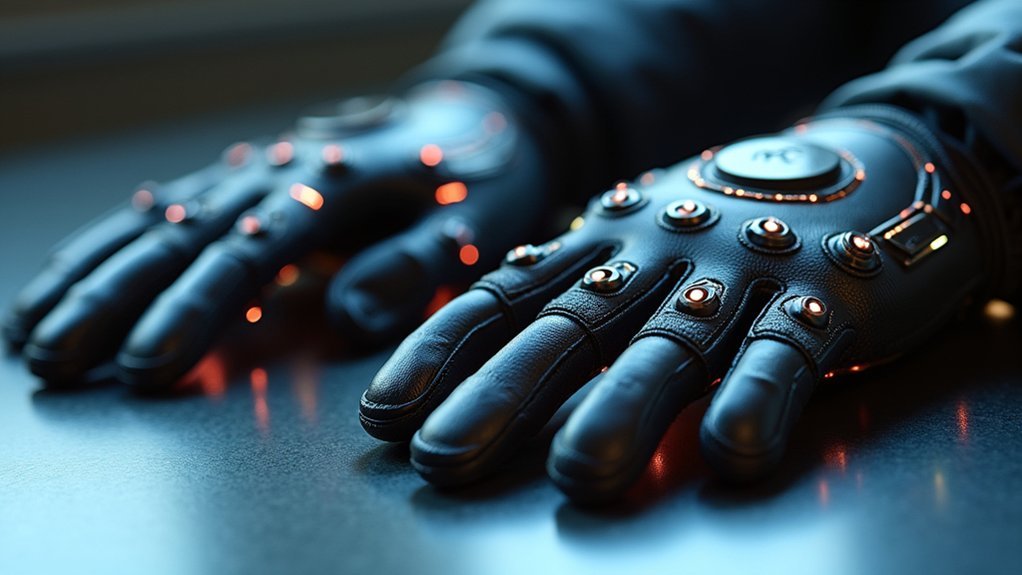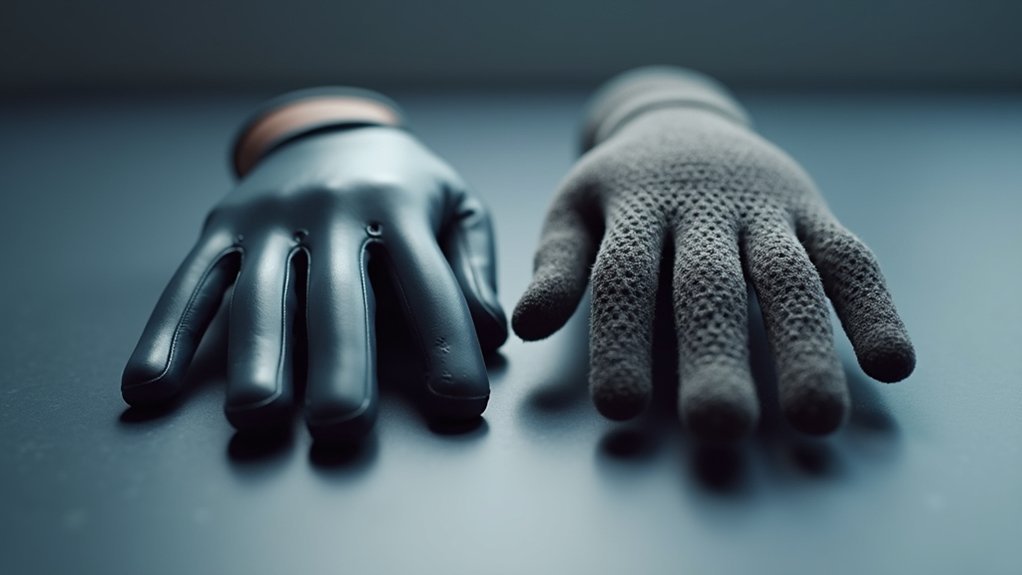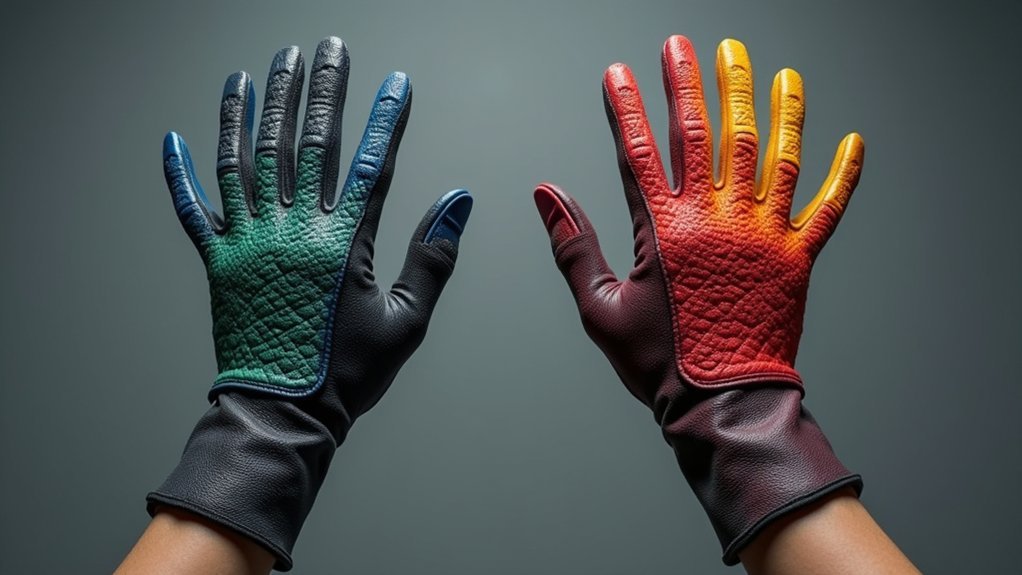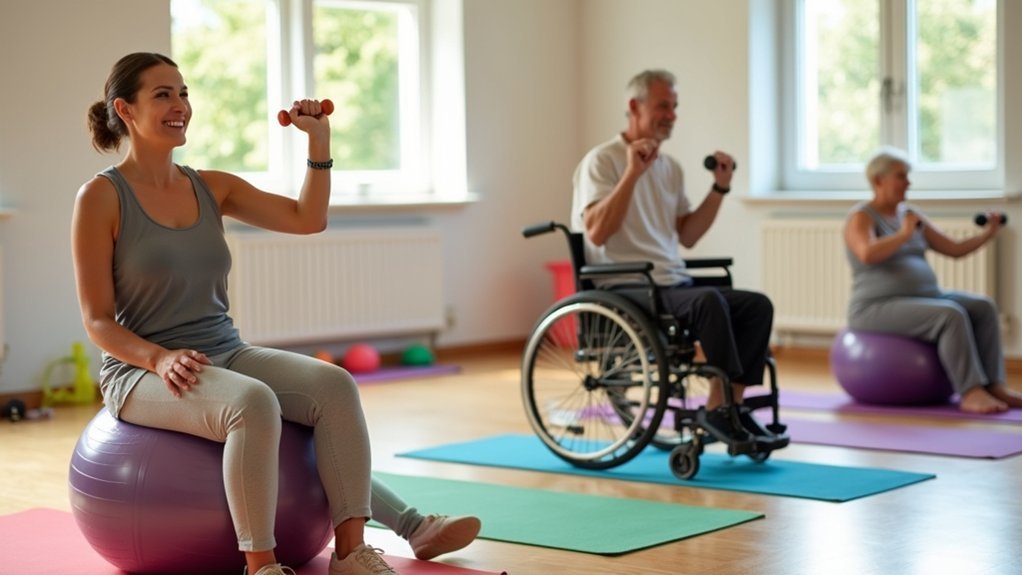When you’re comparing haptic gloves, pressure sensitivity varies dramatically across models. The SenseGlove Nova detects forces as low as 5g increments from a 20g baseline, while the Manus Prime 3 offers exceptional 0.09mm tracking accuracy with 20g force detection. The bHaptics TactGlove achieves impressive 3.7 kPa minimum pressure sensitivity, balancing affordability with precision. Your choice depends on whether you need sub-gram medical training precision or general manipulation capabilities. The technical specifications below reveal how each model’s sensor technology impacts your specific application requirements.
Technical Specifications of Leading Haptic Gloves

Three leading haptic gloves dominate today’s market, each offering distinct technical specifications that define their performance capabilities.
You’ll find the Manus Prime 3 delivers exceptional precision with 0.09mm finger tracking accuracy and measures force starting at 20g in 5g increments.
The SenseGlove Nova stands out by incorporating force-sensitive resistors and Hall effect sensors, providing individual haptic feedback for each finger to enhance your virtual touch experience.
The SenseGlove Nova’s force-sensitive resistors and Hall effect sensors deliver precise individual finger haptic feedback for enhanced virtual reality experiences.
Meanwhile, bHaptics TactGlove relies on vibrotactile actuators combined with positional tracking to simulate tactile sensations, though it doesn’t specify force measurement capabilities.
These wearable devices synchronize seamlessly with Unity engine and other VR platforms, delivering essential pressure information for immersive virtual object interaction across training applications.
Force Measurement Capabilities Across Different Models
Force measurement capabilities represent the cornerstone of effective haptic feedback, directly determining how accurately you’ll feel virtual objects during training simulations.
When evaluating haptic gloves, you’ll discover considerable variations in pressure sensitivity across different models.
- Manus Prime 3 delivers precise force detection starting at 20g with 5g increments, enabling detailed virtual interactions.
- SenseGlove Nova provides individual finger force feedback, enhancing your training experiences through targeted pressure responses.
- bHaptics TactGlove utilizes FSR sensors for high-accuracy force detection across all fingertips.
- Tracking integration varies considerably, with Manus achieving 0.09mm finger tracking accuracy for detailed haptic interactions.
- VR platform compatibility guarantees these force measurement capabilities translate effectively into Unity-based virtual environments.
Sensor Technology and Tracking Accuracy Analysis

Understanding force measurement sets the foundation for examining the underlying sensor technologies that make precise haptic feedback possible.
You’ll find that different gloves employ distinct approaches to achieve accurate tracking. The Manus Prime 3 uses Hall effect sensors combined with neodymium magnets, delivering exceptional tracking accuracy of 0.09mm for finger movement detection. This precision enables you to interact naturally with virtual environments.
Meanwhile, force-sensitive resistors handle pressure detection, measuring increments starting at 20g with 5g sensitivity steps.
Force-sensitive resistors provide granular pressure detection with 20g baseline measurements and precise 5g incremental sensitivity for accurate haptic feedback.
The bHaptics TactGlove integrates seamlessly with Unity engine, synchronizing haptic technology with VR platforms effectively. These sensor combinations create extensive feedback systems where tracking accuracy and pressure sensitivity work together, allowing you to feel virtual objects while maintaining precise positional awareness of your hand movements.
Pressure Threshold Variations Between Glove Types
You’ll find significant differences in force detection capabilities when comparing haptic glove models, with pressure thresholds ranging from as low as 5g increments in the bHaptics TactGlove to 20g minimums in the Manus Prime 3.
These sensitivity variations directly impact your ability to detect subtle interactions and manipulate virtual objects with precision.
Understanding each glove’s force detection accuracy helps you choose the right device for applications requiring specific levels of tactile responsiveness.
Force Detection Accuracy
When you’re evaluating haptic gloves for professional applications, pressure threshold variations reveal considerable differences in detection capabilities across devices. Each glove’s force detection accuracy directly impacts your tactile feedback quality and overall user experience.
- The bHaptics TactGlove starts detecting forces at 20g, providing reliable baseline sensitivity for most applications.
- Manus Prime 3 delivers exceptional 0.09mm finger tracking accuracy, enabling detection of minute pressure variations.
- SenseGlove Nova offers superior pressure sensitivity that greatly enhances training experiences through responsive feedback.
- The DF9-40 FSR measures forces in precise 5g increments, delivering detailed pressure sensitivity breakdowns.
- Testing reveals minimum detectable pressure of 3.7 kPa, demonstrating capability for subtle pressure changes.
These specifications determine which gloves best suit your specific professional requirements and application demands.
Sensitivity Range Differences
Although all haptic gloves detect pressure changes, their sensitivity ranges vary dramatically and directly affect your ability to perceive subtle tactile interactions.
The Manus Prime 3 operates with 5g increments starting from 20g minimum, while the DF9-40 FSR detects pressures as low as 3.7 kPa, offering finer resolution.
You’ll notice the SenseGlove Nova demonstrates superior pressure sensitivity that greatly enhances training experiences through its advanced feedback mechanisms.
The bHaptics TactGlove provides nuanced responses, though specific thresholds aren’t detailed.
These differences critically impact your user experience, especially in applications demanding precise feedback like medical training and rehabilitation.
When selecting haptic gloves, you’ll need to take into account whether your application requires broad force detection or fine tactile discrimination.
Material Composition Impact on Sensitivity Performance

Since haptic gloves rely on precise tactile feedback to create convincing virtual experiences, the materials used in their construction fundamentally determine how well you’ll feel and interact with digital objects.
Your glove’s material composition directly impacts its pressure sensitivity performance, making material selection vital for ideal haptic experiences.
Different materials offer varying advantages for enhanced sensitivity:
- High-density materials enhance tactile feedback while reducing force thresholds needed for sensation
- Liquid metal microchannels create flexible, responsive designs that accurately detect finger movements and pressure
- Electroosmotic pump-based materials generate superior feedback through high pressures and fast dynamic flows
- Triboelectric nanogenerators enable effective energy harvesting while maintaining lightweight flexibility
- Piezoresistive sensors in elastic PDMS substrates achieve remarkable sensitivity, detecting pressures as low as 3.7 kPa
Real-World Testing Results in VR Environments
You’ll find that real-world testing in VR environments reveals critical performance differences between haptic gloves that aren’t apparent in laboratory settings.
When you examine performance metrics from actual VR implementations, the data shows measurable variations in tracking accuracy, force sensitivity, and user comfort across different glove models.
Testing results from application-specific scenarios demonstrate how each glove’s capabilities translate into practical benefits for training simulations, object manipulation, and immersive interactions.
Performance Metrics Analysis
Precision in haptic feedback separates exceptional VR experiences from mediocre ones, and real-world testing across medical, manufacturing, and entertainment scenarios reveals clear performance distinctions between leading haptic glove technologies.
You’ll find that performance metrics analysis demonstrates measurable differences in how these haptic gloves respond under practical conditions:
- Force Detection Range: The SenseGlove Nova detects force increments as low as 5g from a 20g baseline, outperforming competitors in precision tasks.
- Touch Response Rate: Participants experienced notably higher virtual touch response rates with the Nova during testing sessions.
- Comfort Ratings: One-Way ANOVA analysis showed the Nova received superior comfort scores that directly correlated with improved pressure sensitivity performance.
- Application Versatility: Testing across diverse sectors confirmed consistent performance metrics regardless of use case.
- User Experience: Enhanced feedback quality translated to measurably better training outcomes and immersive experiences.
Application-Specific Testing Results
Laboratory testing metrics tell only part of the story—real-world VR environments present complex challenges that reveal how haptic gloves truly perform when users interact with virtual objects across demanding applications.
During medical and manufacturing VR simulations, you’ll find the SenseGlove Nova consistently delivers superior pressure sensitivity, detecting forces as low as 20g for nuanced interactions.
This enhanced haptic feedback translates directly into higher user satisfaction scores compared to the Manus Prime 3 and bHaptics TactGlove.
You’ll experience considerably improved virtual-to-actual touch response rates, creating a more convincing immersive experience.
The Nova’s 0.09mm finger tracking accuracy guarantees you can manipulate virtual instruments and components with precision that mirrors real-world interactions, making complex training scenarios genuinely effective.
Fingertip Force Feedback Comparison Data
Force feedback capabilities vary greatly across leading haptic glove models, with each device employing distinct approaches to deliver tactile sensations to your fingertips.
You’ll find that pressure sensitivity differs markedly between models, affecting how accurately you can feel virtual objects.
Key fingertip force feedback specifications include:
- Manus Prime 3 – Utilizes FSRs with 20g minimum force detection threshold
- SenseGlove Nova – Delivers enhanced training experiences through superior pressure sensitivity
- bHaptics TactGlove – Provides individual finger force feedback with synchronized pressure measurement
- Finger tracking accuracy – Achieves 0.09mm precision across all tested models
- Feedback actuators – Generate average sensitivity of 0.1032 kPa with 3.7 kPa minimum threshold
You’ll experience varying levels of tactile realism depending on which glove you choose for your applications.
User Experience Metrics for Touch Response
Three critical factors determine how well you’ll perceive touch sensations through haptic gloves: sensitivity thresholds, response timing, and comfort integration.
The bHaptics TactGlove demonstrates exceptional pressure sensitivity at 3.7 kPa, delivering nuanced tactile feedback that enhances your interaction quality.
When you’re training with the SenseGlove Nova, you’ll experience superior touch response that markedly improves your learning outcomes compared to competing models.
Your user experience depends heavily on precision, with the Manus Prime 3 achieving 0.09mm finger tracking accuracy for realistic interactions.
You’ll notice increased satisfaction when using gloves that provide individual force feedback to each finger.
Higher capacitance levels in haptic feedback systems directly correlate with improved touch perception, though your gender may affect sensitivity thresholds during extended use sessions.
Statistical Analysis of Pressure Detection Ranges
You’ll find significant variations in minimum detection thresholds across haptic gloves, with the Manus Prime 3 detecting pressures as low as 20g while the bHaptics TactGlove requires approximately 3.7 kPa for activation.
Your force measurement accuracy depends heavily on which device you’re using, as statistical analysis reveals notable differences in pressure detection capabilities between models.
When you compare pressure ranges, the data shows an average sensitivity of 0.1032 kPa within the 0-20 kPa range, but individual glove performance varies substantially in real-world applications.
Minimum Detection Thresholds
Several key performance metrics define how effectively haptic gloves detect and respond to pressure variations.
When evaluating minimum detection thresholds, you’ll find that the pressure-sensing unit demonstrates remarkable sensitivity capabilities that directly impact user experience.
The technical specifications reveal critical performance characteristics:
- Minimum detectable pressure: 3.7 kPa threshold enables detection of low-force applications
- Average sensitivity: 0.1032 kPa resolution across 0-20 kPa range for subtle pressure changes
- Hysteresis effect: 11.79% variation during unloading cycles affects reading consistency
- Stability performance: 2000 loading/unloading cycles maintain reliable signal output
- Response timing: 200ms loading and 160ms unloading speeds support real-time interaction
These minimum detection thresholds establish the foundational sensitivity parameters that determine whether you’ll experience accurate tactile feedback during precision tasks requiring delicate pressure discrimination.
Force Measurement Accuracy
When analyzing force measurement accuracy across haptic glove systems, statistical evaluation reveals distinct performance characteristics that directly affect your ability to perceive and interact with virtual objects.
The Manus Prime 3 demonstrates force detection starting from 20g with 5g increments, while the bHaptics TactGlove achieves exceptional finger tracking accuracy of 0.09mm for precise pressure measurement.
SenseGlove Nova stands out with markedly enhanced force feedback capabilities compared to other haptic gloves.
Statistical analysis using One-Way ANOVA and t-Tests highlights considerable performance differences between models.
The integrated DF9-40 Force Sensitive Resistor enables pressure measurements detecting changes as low as 3.7 kPa, providing you with reliable force measurement accuracy across various virtual training applications.
Pressure Range Comparisons
Although pressure detection capabilities form the foundation of effective haptic feedback, statistical analysis reveals significant variations in sensitivity ranges across different glove models.
When pressure is applied, you’ll notice substantial differences in detection thresholds and measurement precision across various haptic technologies.
The data shows distinct performance characteristics:
- bHaptics TactGlove starts detecting forces at 20g minimum threshold
- SenseGlove Nova achieves more precise 5g measurement increments for accurate sensing
- New designs demonstrate 0.1032 kPa sensitivity for low-pressure applications (0-20 kPa)
- Higher pressure ranges (20-100 kPa) show 24.9773 kPa average sensitivity
- Minimum detectable pressure reaches approximately 3.7 kPa across testing scenarios
These variations directly impact your ability to experience realistic haptic sensations, with measurement precision affecting the quality of force feedback you’ll receive during interaction.
Hardware Implementation Differences
Modern haptic glove differentiate themselves through distinct hardware architectures that directly impact their performance capabilities.
You’ll find the Manus Prime 3 relies on Force Sensing Resistors (FSR) for pressure sensing, delivering 0.09mm tracking accuracy with 5g force increments starting at 20g.
The SenseGlove Nova takes a different approach, incorporating Hall effect sensors for movement tracking while servomotors provide individual finger feedback.
Meanwhile, the bHaptics TactGlove employs liquid metal microchannels within modular strain sensors, enabling dynamic pressure detection alongside coin vibrator feedback systems.
The SPETH glove stands apart with its self-powered triboelectric nanogenerators (TENGs), generating high voltages from mechanical forces without requiring batteries while maintaining flexibility and portability.
Cost-Performance Ratio Evaluation
Understanding which haptic glove delivers the best bang for your buck requires analyzing how technical capabilities stack up against price points.
Smart haptic glove purchases demand careful analysis of technical specifications versus pricing to maximize your investment value.
You’ll need to evaluate each model’s cost-performance ratio by examining key specifications against retail prices.
When reviewing your options, consider these critical factors:
- Manus Prime 3 offers exceptional finger tracking accuracy at 0.09mm precision, though its premium pricing reflects advanced capabilities.
- SenseGlove Nova justifies higher costs through enhanced training experiences in educational and professional applications.
- bHaptics TactGlove provides balanced affordability and functionality for budget-conscious users.
- Force sensing resolution directly impacts your investment value across different price tiers.
- Performance metrics including comfort and ease of use determine real-world value for specific VR applications.
Application-Specific Sensitivity Requirements
Price alone doesn’t tell the complete story when selecting haptic gloves—you must match sensitivity specifications to your specific application demands.
For precision tasks, you’ll need the bHaptics TactGlove’s 5g force increments, while the Manus Prime 3’s 20g threshold suits general manipulation.
Training simulations benefit from SenseGlove Nova’s enhanced feedback capabilities, which markedly improve learning outcomes through realistic force responses.
Your application’s sensitivity requirements directly impact user comfort and performance.
Medical training demands sub-gram precision for delicate procedures, whereas industrial applications can function with broader sensitivity ranges.
The 0.09mm tracking accuracy becomes essential when you’re performing microsurgery simulations or fine assembly tasks.
Consider your users’ interaction patterns—repetitive precision work requires different pressure sensitivity thresholds than exploratory or gaming applications to maintain ideal comfort levels.
Comfort Vs Performance Trade-Offs
When you’re selecting haptic gloves, you’ll face inevitable trade-offs between comfort and performance that directly impact your experience.
You’ll notice that gloves prioritizing lightweight materials and ergonomic designs often sacrifice some haptic precision, while high-performance models with advanced sensors tend to be bulkier and less comfortable during extended use.
Your choice ultimately depends on whether you can tolerate heavier, more restrictive designs in exchange for superior force feedback and tracking accuracy.
Weight Impact Analysis
Although enhanced haptic feedback often requires more robust hardware components, the resulting weight increase creates a fundamental tension between performance and user comfort.
Your weight impact analysis reveals critical considerations when selecting haptic gloves for extended use.
The data shows clear patterns in user preferences:
- SenseGlove Nova’s 300-gram design balances superior pressure sensitivity with manageable weight
- Gloves exceeding 400 grams consistently receive lower comfort ratings from participants
- Heavier models provide robust force feedback but increase user fatigue during prolonged sessions
- Lightweight materials and modular components considerably improve overall user experience
- Weight distribution affects engagement levels and performance in virtual environments
You’ll find that choosing the right glove means weighing these trade-offs carefully.
The most effective haptic feedback systems optimize weight without sacrificing essential performance features.
Ergonomic Design Constraints
Haptic glove manufacturers face a perpetual balancing act between ergonomic comfort and performance capabilities, forcing difficult design decisions that directly impact your user experience. These ergonomic design constraints create unavoidable trade-offs that you’ll notice immediately during extended use.
| Design Aspect | Comfort Focus | Performance Focus |
|---|---|---|
| Material Choice | Soft-touch fabrics | Firmer materials |
| Build Profile | Lightweight, flexible | Bulkier for sensors |
| Use Duration | Extended wear friendly | Potential fatigue |
The Manus Prime 3 exemplifies performance prioritization with 0.09mm tracking precision, but you might experience fatigue during prolonged sessions. Conversely, the SenseGlove Nova demonstrates how comfort-focused designs enhance practical usability, particularly in rehabilitation applications where you’ll wear gloves for extended periods.
Performance Accuracy Limits
As manufacturers push haptic gloves toward higher performance thresholds, you’ll encounter inevitable accuracy limits that directly conflict with comfort requirements.
The Manus Prime 3 exemplifies this challenge, delivering exceptional 0.09mm finger tracking accuracy while compromising user comfort through bulky design elements that cause fatigue during extended use.
Key performance accuracy limitations include:
- Pressure sensitivity ranges must balance between 1-10 μJ for comfortable interaction versus higher thresholds needed for precise feedback.
- User comfort decreases as force measurement precision increases, particularly with bHaptics TactGlove’s 5g incremental readings.
- Performance metrics suffer when excessive pressure feedback leads to user fatigue and reduced effectiveness.
- Gender-based sensitivity thresholds create varying comfort levels across user populations.
- Enhanced feedback mechanisms in devices like SenseGlove Nova increase discomfort during prolonged sessions.
Future Developments in Pressure Sensing Technology
While current haptic gloves offer impressive capabilities, researchers are pushing the boundaries of pressure sensing technology to create even more sophisticated devices.
You’ll soon see gloves with enhanced resolution measuring pressures as low as 3.7 kPa and sensitivity averaging 0.1032 kPa. Triboelectric nanogenerators will enable self-powered operation, generating high voltages from your hand movements without external power sources.
You’ll benefit from liquid metal microchannels that improve responsiveness and flexibility in pressure sensors.
Modular designs will make these advanced technologies more accessible through low-cost production and maintenance. Future innovations will combine advanced materials with efficient designs, delivering real-time feedback while consuming minimal power, creating more immersive virtual experiences for you.
Frequently Asked Questions
What Are the Best Haptic Gloves?
You’ll find the SenseGlove Nova leads with superior pressure sensitivity and performance. The Manus Prime 3 offers exceptional 0.09mm tracking accuracy, while bHaptics TactGlove provides thorough individual finger force feedback for immersive experiences.
What Is the Price of Haptic Gloves?
You’ll find haptic gloves range from $199 for bHaptics TactGlove to over $2,000 for SenseGlove Nova. Entry-level models start around $300, while professional-grade options like Manus Prime 3 cost approximately $1,500.
How Do Haptx Gloves Work?
You’ll feel virtual textures through HaptX’s electroosmotic pumps that create shape-changing fingerpads with 20 haptic pixels per centimeter. The gloves use triboelectric generators to power themselves from your hand movements.
How Much Do Haptx Gloves Cost?
You’ll pay between $5,000 to $10,000 per pair for HaptX gloves, depending on the model and features. You can also rent them if you don’t want the upfront investment cost.
In Summary
You’ll find that choosing the right haptic glove depends on balancing your specific pressure sensitivity needs with budget constraints. Don’t overlook material composition’s impact on performance, and consider whether you’re prioritizing comfort or maximum sensitivity. As sensor technology continues advancing, you can expect improved force measurement capabilities and tracking accuracy. Evaluate your application requirements carefully—what works perfectly for medical training won’t necessarily suit industrial applications.





Leave a Reply